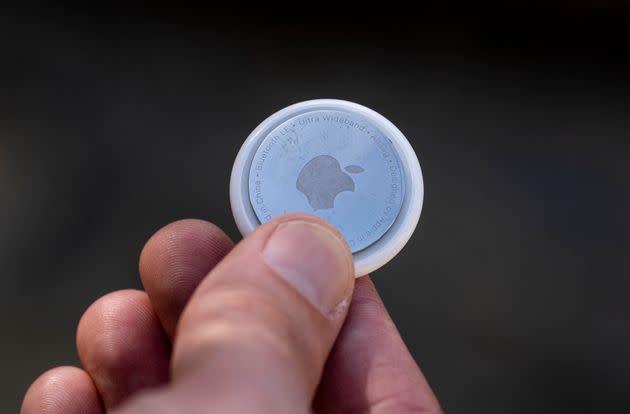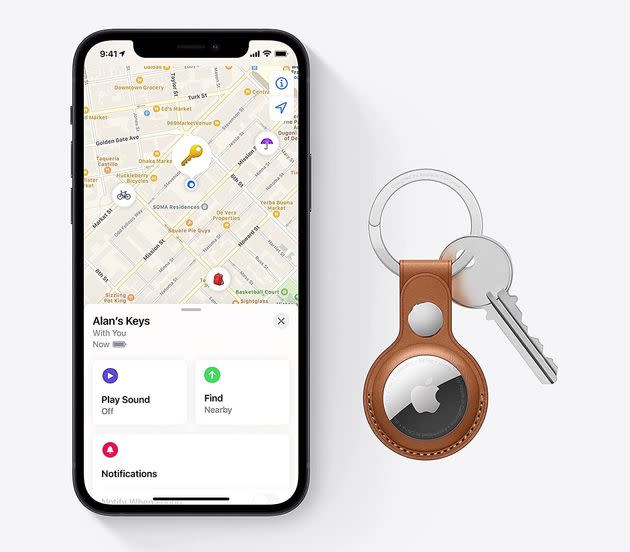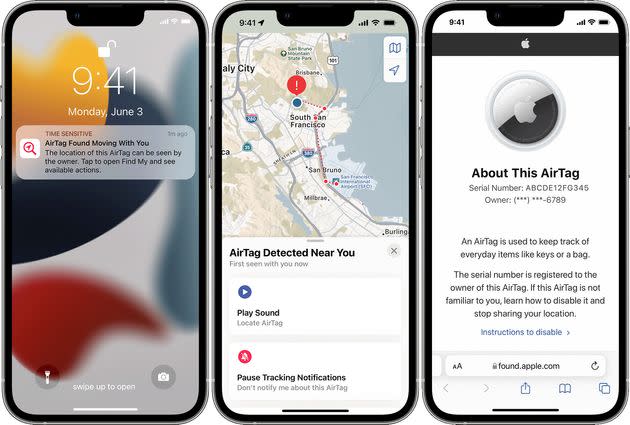What You Need To Know About The Apple AirTag Tracking Dangers

AirTags are small enough to be attached to keys and luggage without being intrusive -- something that stalkers have taken advantage of.
Apple’s AirTags are receiving a lot of attention ― not all of it positive. These quarter-sized Bluetooth trackers are meant to be attached to belongings like luggage, backpacks and wallets to help users find those items if they go missing.
But police have confirmed instances of stalkers using AirTags to track victims, and thieves using AirTags to try to steal vehicles. People have reported feeling unnerved after receiving alerts suggesting they are being tracked by unknown AirTags, and some have found mysterious AirTags attached to their cars. Last week, two women filed a lawsuit against Apple alleging that AirTags are a “dangerous product” that “has become the weapon of choice of stalkers and abusers.”
“I was concerned ahead of their release as soon as I figured out how they worked,” Eva Galperin, Electronic Frontier Foundation’s director of cybersecurity, told NPR earlier this year. “I was concerned very shortly after they were released when I started seeing reports of stalking and being contacted by people who were being stalked using these devices.”
A little update. pic.twitter.com/VnH1rVOjgV
— Brittany Rose (@bcreel95) November 6, 2022
In February, Apple condemned the criminal use of AirTags, and the company promised to release further product updates and advancements in 2022 that would “help guard against further unwanted tracking.” So far, Apple has released firmware updates to include new privacy warnings upon sign-up, alert users sooner to tracking by unknown AirTags, and tune the sound that AirTags make.
Here‘s what you need to know — and what it might mean if you get an alert that suggests you’re being tracked.
How does an AirTag work?
Like a lot of tech companies, Apple uses Bluetooth wireless technology on nearly all of its products, from iPhones to Apple Watches, MacBooks, and more. Bluetooth signals, which are wavelengths that connect devices within a short range, allow us to enjoy wireless earbuds like AirPods, or AirDrop photos or files to another user who has their receiving setting turned on. They also enable the Find My app you can use when your Apple items are lost.
AirTags aren’t exactly GPS trackers, but each one does ping its location to all Apple devices it’s registered with. AirTags work by privately exchanging encrypted signals with other Apple devices in their immediate vicinity, creating a virtual network that compensates for the fact that Bluetooth signals typically don’t travel farther than about 30 feet.
Let’s say you’re in Toronto, but your suitcase, unfortunately, is sitting in the Cincinnati airport. If certain other Apple devices with internet connections are near the AirTag you put in your suitcase, those devices will anonymously pick up the AirTag’s Bluetooth signals and relay them to your phone so you know where your luggage is.

AirTags feature "precision finding," according to Apple.
AirTags pair with your personal devices, so you’ll likely know if one isn’t yours.
For iOS users running recent software, Apple updated the AirTags system to keep users safer. When you buy an AirTag for your belongings and pair it with your iPhone, it is permanently matched with your Apple ID. This means it doesn’t even show up for others in your family sharing group, and if you ever borrow someone else’s AirTag, they’ll have to remove their identification first before you can use it.
Because of this personalized identification, users also receive alerts if an AirTag in their proximity isn’t their own. This alert reads “AirTag Found Moving With You” and offers a warning: “The location of this AirTag can be seen by the owner.”
This has caused a number of people to fear they’re being stalked or tracked without their consent.
The pop-up warning doesn’t always mean you’re being tracked…
Apple has noted that just because this alert pops up, that doesn’t automatically mean you are being tracked. The pop-up can appear on a person’s phone if an AirTag owner and their iPhone are separated by a certain distance, or if someone loses their AirTag. Then, an alert shows up on the phones of people in the vicinity.
“Individuals can receive unwanted tracking alerts for benign reasons, such as when borrowing someone’s keys with an AirTag attached, or when traveling in a car with a family member’s AirPods left inside,” Apple said in its February statement.

If an AirTag is separated from its owner and moving with you, you'll get an alert that will allow you to play a sound to find it and look up information about it.
...but here’s how to check, and what to do if you find one.
If you do get an alert about an unknown AirTag nearby, you can follow instructions to play a sound on the AirTag to help you locate it.And if you find an unwelcome AirTag in or on your belongings, you can take out the battery. This stops the location tracking, but it also alerts the AirTag’s owner. Because of this, NPR reported, some law enforcement agencies have advised against removing the battery in case it contaminates potential evidence of something sinister.
Apple recommended you take the following steps if you discover a potentially malicious AirTag, since simply disabling Find My and turning off Bluetooth or Location Services on your iPhone won’t prevent the owner of the suspicious AirTag from seeing its location.
If you have found an AirTag, hold the top of your iPhone or NFC-capable smartphone near the white side of the AirTag until a notification appears.
Tap the notification. This opens a website that provides information about the AirTag, including its serial number and the last four digits of the phone number of the person who registered it. This can help you identify the owner, if you know them. You might want to take a screenshot to make sure that you can document the information.
If the owner marked the AirTag as lost, you might see a message with information about how to contact the owner.
From there, you can disable the device without removing the battery. Tap “Instructions to Disable” and follow the steps. The original AirTag owner will no longer see your location after that, and, if needed, you can report the device to law enforcement.
In cases that may involve ill intent, Apple can provide an AirTag’s account details to police “in response to a subpoena or valid request from law enforcement,” the company said. “We have successfully partnered with [law enforcement] on cases where information we provided has been used to trace an AirTag back to the perpetrator, who was then apprehended and charged.”
If the AirTag issue raises privacy concerns in general, it may be a good idea to check who is able to track you via the location services in your phone. Go to your Settings and click on Privacy. Find “Location Services.” There you’ll see a list of apps that currently have access to your location. You can adjust the tracking permissions or delete the apps entirely, depending on what feels comfortable.
And if you’ve previously shared your iPhone location with someone else and now want to end that:
Open the Find My app.
Tap on “People.”
Select the person you want to stop sharing your location with.
Tap on “Stop Sharing My Location.”
On the “Me” menu on the Find My app, you can also turn off sharing your location in general.
If you want to double-check what devices are connected to your iPhone, go to “Bluetooth” in Settings and view each device that has been paired to your phone. This could include everything from AirPods to AirTags to car stereo systems.
If you’re an Android user, you will see a Bluetooth icon at the top of your screen. Go to Settings and view “Connected Devices.”
Can I detect AirTags with an Android?
Since AirTags use Apple’s specific U1 chip, the devices don’t work as well for non-Apple products. The first issue that Android users will encounter is that only Apple users are able to register an AirTag as their own through the Find My app. Android users won’t be able to find their AirTags on a map, either.
So, how can they spot AirTags? Apple has released an app for Android users called Tracker Detect that allows you to manually search for AirTags that aren’t your own and that might be tracking you. This will show AirTags that aren’t in the Bluetooth range of your device, according to Lifewire. The app also lets users play a sound on any tracking device it detects for longer than 10 minutes, so that you will be able to find it.
So, are AirTags safe?
Yes and no, an expert told us.
“There are some good and bad things with Apple AirTags,” said Dr. Stavros Shiaeles, a cybersecurity expert at the University of Portsmouth. Shiaeles noted that AirTags do in fact help you locate lost items. But he warns against using Bluetooth when you don’t need it, and recommends keeping all the software on your Bluetooth-enabled devices up to date.
Shiaeles said that AirTags are one more privacy concern to think about.
“Apple knows everything that you have,” he said. Just as it’s possible to build a profile of an influencer’s daily habits based on what they reveal on social media, someone could build a profile of you based on what an AirTag might reveal. For example, if the device remained in your car, an AirTag owner could be able to see the locations you visit on a daily basis.
“If you have this device continuously with you, in your car, I can profile you,” Shiaeles said.
Need help? In the U.S., call 1-866-331-9474 or text “loveis” to 22522 for the National Dating Abuse Helpline.
